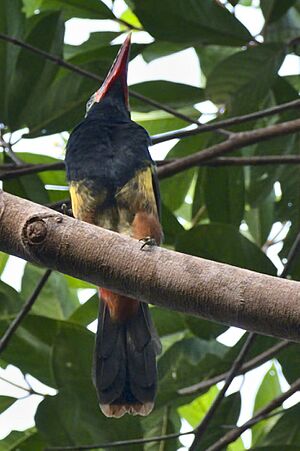Tawny-tufted toucanet facts for kids
Quick facts for kids Tawny-tufted toucanet |
|
|---|---|
 |
|
| Conservation status | |
| Scientific classification | |
| Genus: |
Selenidera
|
| Species: |
nattereri
|
 |
|
| Synonyms | |
|
|
The tawny-tufted toucanet (Selenidera nattereri) is a colorful bird. It belongs to the toucan family, called Ramphastidae. You can find this bird in countries like Brazil, Colombia, and Venezuela. It might also live in Guyana.
Contents
About its Name
When the tawny-tufted toucanet was first described, scientists gave it a different name. It was first called Pteroglossus. This bird is a monotypic species. This means there is only one type of tawny-tufted toucanet. There are no different subspecies or kinds of it.
What it Looks Like
The tawny-tufted toucanet is about 32 to 33 centimeters (about 13 inches) long. It weighs between 148 and 165 grams (about 5 to 6 ounces). Both male and female toucanets have similar beaks. However, the female's beak is a bit shorter.
Beak Colors
The beak has a red line at its base. The top part of the beak, called the culmen, is green or lime green. The rest of the upper beak is red. It also has a blue patch near the base and pale "teeth" along the edge. The lower beak is mostly brownish-red. It can sometimes be greenish. It has a blue patch near the base, a green tip, and white lines in the middle.
Feather Colors
Both male and female toucanets have pale blue skin around their eyes. They also have a yellow or tawny (light brown) tuft of feathers behind their eyes.
- Males: Males have a black head, neck, chin, throat, and belly. Their upper body is green. They have a yellow band on their lower neck. Their tail is green with chestnut tips on some feathers. Their sides are yellow or rusty. The feathers under their tail are red.
- Females: Females have a chestnut-colored head down to their shoulders. Their chin and belly are rusty. Their sides are greenish-yellow. Their facial skin and feather tuft are paler than the males'.
Where it Lives
The tawny-tufted toucanet lives in different areas. You can find it in eastern Colombia and southern Venezuela. It also lives in northwestern Brazil, north of the Solimões River. This river is also known as the upper Amazon River. It goes as far east as the upper Rio Negro. Some people think they have seen this bird in Guyana. However, this has not been fully confirmed.
Its Home
This toucanet lives in forests. It often prefers forests with sandy soil. It also likes to be near waterways, like rivers or streams.
How it Behaves
Movement
As far as we know, the tawny-tufted toucanet stays in the same area all year. It does not migrate to different places.
Feeding Habits
We know that the tawny-tufted toucanet eats fruit. However, scientists do not know much else about its diet. We also do not know how it finds its food.
Reproduction
Scientists believe the tawny-tufted toucanet's breeding season is between April and November. It might start as early as March and end in May. We do not know much about its nests or eggs. We also do not know how long the eggs take to hatch. The time it takes for young birds to leave the nest is also unknown.
Vocalization
The tawny-tufted toucanet makes sounds that are like "grown-like, croaking, 'ggruuukk' notes." These sounds can last for 10 to 15 seconds. It also makes a "more rattling version, 'dddrik-'."
Conservation Status
The IUCN (International Union for Conservation of Nature) has looked at the tawny-tufted toucanet. They have listed it as "Least Concern." This means it is not currently in danger of disappearing. It lives in a large area. However, we do not know how many of these birds there are. We also do not know if their numbers are going up or down. There are no immediate threats to this bird that scientists have found. More information is needed about its home and what it eats. We also need to learn more about how it breeds and behaves.


